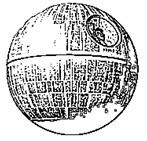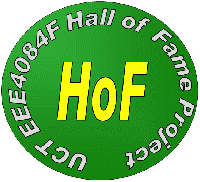| Home | Videos | Slides | Assignments & Resources | Tests | Exams | YODA Topics | Hall
of Fame |

 |
|||||
Projects |
|
||||
Team: Daniel Galasko, Lynn Assimwe, Victor Mushabe  |
DEATHSTAR (Data Encryption Accelerator That Handles Security Tasks Anytime Readily) P15, 2012The objective the Data Encryption Accelerator That Handles Security Tasks Anytime Readily (DEATHSTAR) is to accelerate the process of encrypting a data stream. First the rst (reset) control line is clocked, this causes the DEA to reset any internal buffers and storage. Next, an encryption key is set by writing the (a single byte value) of the key to the din (data input) 8-bit data input bus, and then sending a positive edge to the kset (key set) control line. The dclk (data clock) is kept low. After this, the actual encryption starts, which involves iterating through all the data, one byte at a time, by writing a byte of data to the din input lines, then clock dclk clock line. The encrypted data is (pretty much) immediately available on the DEA's dout 8-bit output lines. The latter process is repeated for each item of data. To start with a simple XOR encryption is used as the encryption method. If time permits, this is taken further using a repeating pattern based on the key input.
|
||||
Team: Lloyd Hughes, Stephen Jermy, Ross Engers  |
PADAWAN - Parallel Accelerator for Digitising Audio With Attenuation of Noise P17, 2012Defining the problem and suggested solution: The problem to be solved is performing filtering and processing on audio in near real-time using a FPGA. Real-time filtering can be achieved in software, however when many filters are cascaded one after the other there will be a delay between audio input and output. For many applications this is an undesirable side-effect, stopping the system from being real time. Some types of filters that can be implemented are: Low-pass, high-pass, band-pass and band-stop. Some effects that can be implemented are: Echo, flange, chorus, reverb, vibrato, phaser, delay and distortion. (Why the acronym you might ask? Kind of obvious from this reference.) Click on the PADAWAN project details to find out more, or download the whole project zip file from the link below.
|
||||
Team: Daniel Donaldson, Gregory Ireland  |
VADER – Versatile Accelerated Digital Encryption Recovery P16, 2012The VADER system is a digitally accelerated add-on hardware device designed to recover passwords using an acquired hashed password and hashing function. Uses of such a device could be to speed up computationally expensive recovery of passwords for forensic purposes such as instances where a victim or suspects password protected information could assist in an investigation. In order for the system to begin the specific hashing function used to create the password hashes would need to be acquired; it is assumed that this is available and many commonly used hashing functions are indeed widely available. The hashed version of the password itself would also need to be acquired. The system will run parallelized functions on an FPGA to accelerate the recovery of the password. The system will first run a dictionary type cracking attempt and following this if it is unsuccessful a brute force algorithm will be applied. Click on the VADER project details to find out more, or download the whole project zip file from the link below.
|
||||
 |
|||||
Projects |
|
||||
under development |
Related WebsitesDepartment of Electrical Engineering
Maintained by Simon Winberg @2014 Updated by Tumisang Leqele |



